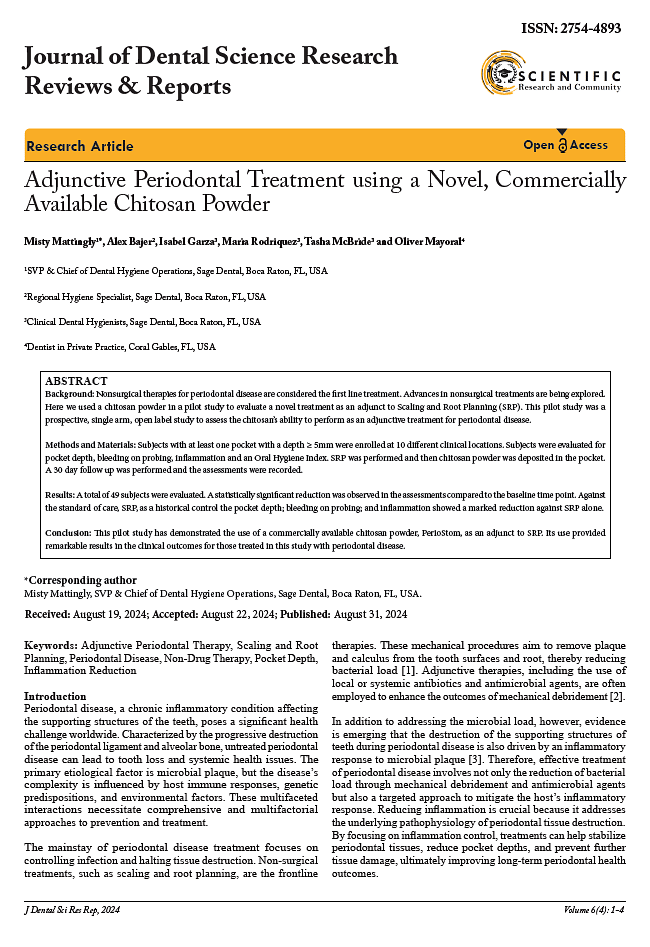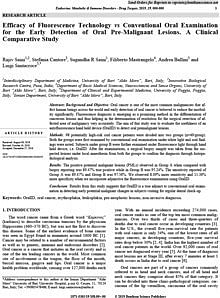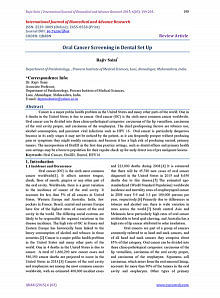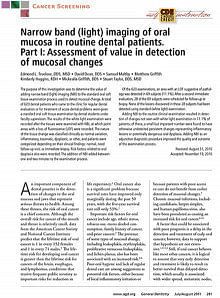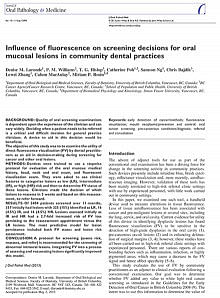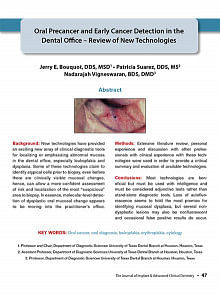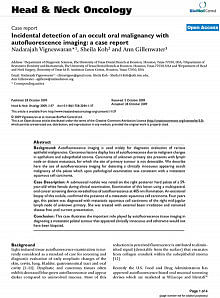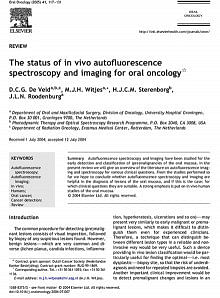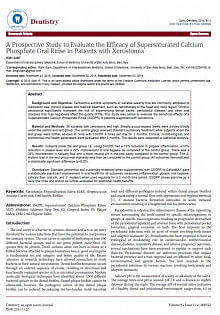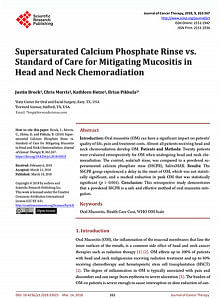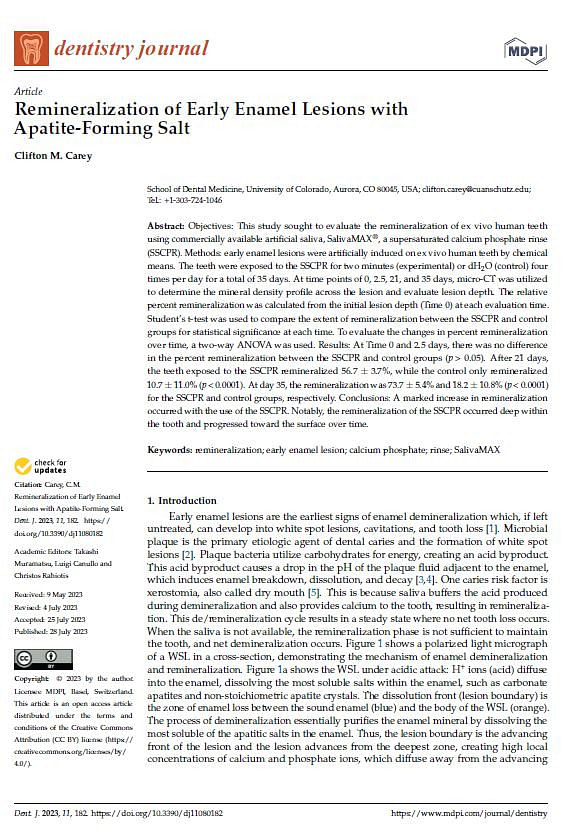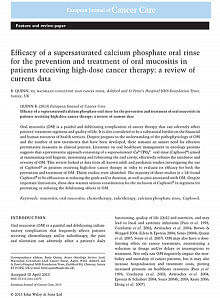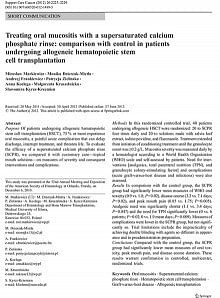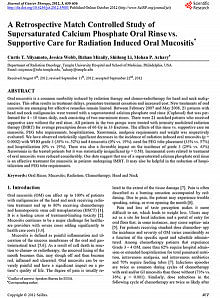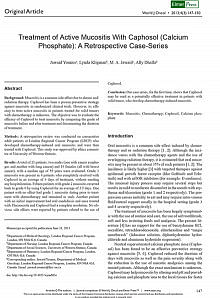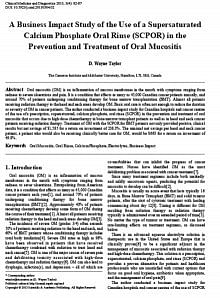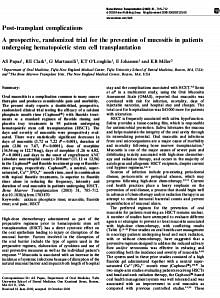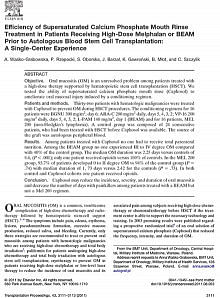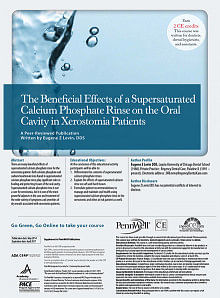Research
Some of the uses, outcomes, and conclusions using PerioStōm® included in this manuscript have not been cleared by the FDA. The authors have no financial interest in Forward Science or PerioStōm®. Forward Science supported this research by providing PerioStōm® product.
Indications for Use:
PerioStōm® is an oral wound dressing intended as a physical barrier for temporary protection of oral mucosal tissue.
Intended Use:
PerioStōm® can be utilized for the protection of oral mucosa due to irritation, trauma, or following iatrogenic procedures such as scaling and root planing.
Contraindications:
PerioStōm® is contraindicated for those with a shellfish allergy.
Tissue fluorescence has been used as an aid in visualization of oral mucosal abnormalities, such as oral cancer and pre-cancer. Fluorescence technology has been used in the medical field for many years, and in the dental field it has successfully screened more than 25 million patients in the past decade.
Saini et al. published a paper using OralID as a screening tool in visualizing oral premalignant lesions. In a high risk population, a conventional oral exam and OralID was compared to only a conventional oral exam.
Biopsies were taken of suspicious lesions in both groups. Sensitivity and specificity both improved; 8.1% and 11.4%, respectively; when clinicians utilized the OralID.
The Conclusion from the study was: “Results from this study suggests that OralID is a true adjunct to conventional oral examination in [visualizing] potential malignant changes in subjects visiting for regular dental check-up.”
This scientific article from the International Journal of Biomedical and Advanced Research explains why oral cancer screening in the dental set up is important. Below are a few statements taken from the journal article:
“…light-tissue interactions can be exploited to improve the visualization of neoplastic lesions.In particular, tissue autofluorescence has recently shown promise as an adjunctive diagnostic tool."
“Oral cancer and pre cancer display a loss of autofluorescence across a broad range of UV and visible excitation wavelengths."
“The incorporation of OralID in the first-line practice settings, such as dental offices and primary health care settings, may be a boon to population for regular check up for pre malignant lesions.”
“There is an enormous amount of advantage of this cost effective device (OralID) in the developing countries where financial liability is the main hindrance during oral cancer screening for the mass population."
Rajiv Saini / International Journal of Biomedical and Advance Research 2015; 6(03): 199-203.
"Adding [fluorescence] as an adjunctive procedure improved the quality and outcome of the examination process."
Laronde et al. describe incorporating a clinical risk assessment in combination with fluorescence to predict lesion persistence. Unsurprisingly, " [t]he most predictive model for lesion persistence included both [fluorescence] status and lesion risk assessment."
"A protocol for screening (assess risk, reassess, and refer) is recommended for the screening of abnormal intraoral lesions. Integrating [fluorescence] into a process of assessing and reassessing lesions significantly improved this model."
"For those clinicians in general practice without the experience and expertise of a specialist, an imaging device to aid in the decision to refer would be very helpful. At the community level, the critical decision is not whether or not the lesion is cancer but whether or not the lesion should be referred for further investigation. Reassessment at a 3-week follow-up appointment is critical to improving the specificity of the FV autofluorescence imaging device."
“It is a good idea to use autofluorescence on an annual basis as a screening tool in the dental office.”
"Subclinical premalignant and malignant lesions that are not visible on routine white light oral examination become noticeable with direct autofluorescence visualization.”
“Autofluorescence imaging can be used to find lesions that are not or not easily noticed by visual inspection.”
”Autofluorescence imaging might be appropriate as an easy-to-use, sensitive and inexpensive method..."
Supersaturated Calcium phosphate rinses are well studied and have been proven effective in treating dry mouth, xerostomia, and mucositis. Below is just a sampling of the available literature.
Saini reports on the results of SalivaMAX in a xerostomic population (n = 38) with high levels of S. mutans. Compared against a control using standard customary treatment, the SalivaMAX group (customary treatment plus SalivaMAX 4x/day) had a statistical (p<0.05) and marked improvement in oral hygiene scores and other measured outcomes.
Brock et al. describes the use of SalivaMAX, a supersaturated calcium phosphate rinse, by head and neck patients receiving 70Gy of fractionated IMRT chemoradiation as compared to the standard of care, a salt/soda rinse. The SalivaMAX group demonstrated a significant reduction in the peak level of mucositis along with a delay in the onset of mucositis during treatment as compared to the control. More specifically, using assessments based on the WHO Oral Mucositis Scale 90% of SalivaMAX patients were eating solid foods with many not even experiencing ulcerations. While in the control group, 40% of the patients were on a liquid diet.
Some of the outcomes, suggestions, and conclusions using SalivaMAX included in this manuscript have not been cleared by the FDA. The author has no financial interest in Forward Science or SalivaMAX. Forward Science supported this research.
SalivaMAX is indicated for dryness of the mouth or throat (hyposalivation, xerostomia, mucositis), regardless of the cause and regardless of whether the condition is temporary or permanent. Relief of dryness of the oral mucosa in these conditions is associated with an amelioration of pain.
SalivaMAX is also indicated as an adjunct to standard oral care in treating the mucositis that may be caused by radiation or high-dose chemotherapy.
SalivaMAX may be used for the relief of dryness of the oral mucosa when hyposalivation results from the following: pre/post-surgery, radiotherapy, chemotherapy, infection or dysfunction of the salivary glands, inflammation of the mouth or throat, fever, emotional factors such as fear or anxiety, obstruction of the salivary ducts, Bell’s Palsy, and Sjogren’s syndrome. SalivaMAX is also indicated for dryness of the oral mucosa due to drugs such as antihistamines, atropine, or other anticholinergic agents that suppress salivary secretion.
SalivaMAX may be used as part of an oral hygiene program for patients with dry mouth. SalivaMAX provides intensive hygiene of the oral cavity and may be used to help relieve bad taste, relieve offensive nasal discharge, and crusting.
This study provided a review of thirty studies and found that the majority (24) reported that a supersaturated calcium phosphate rinse was efficacious at reducing the mucositis grade and/or duration as well as the mucositic pain associated with the condition.
Markiewicz evaluated supersaturated calcium phosphate rinse compared to the standard of care, topical mouth solutions, in patients undergoing high dose chemotherapy. The supersaturated calcium phosphate group showed statistically significant improvements over the control group in:
• need for total parenteral nutrition
• duration of analgesics
• peak mouth pain
• mucositis duration
• oral toxicity severity (WHO scale)
This study evaluated patients that received at least 4500cGy to the oral cavity using supersaturated calcium phosphate rinse compared to standard supportive care. The supersaturated calcium phosphate group showed marked improvements over the control group in:
• PEG tube application
• In-patient hospitalization
• Incremental costs of treatment for oral mucositis (savings of $1,700 - $7,000 per person)
This is a first published study to determine the efficacy of a supersaturated calcium phosphate oral rinse on patients with solid tumors (breast cancer) in response to chemotherapy-induced mucositis. Although this was a single sided study, the short time to elimination of mucositis was noteworthy: resolution of Grade 3 mucositis was an average of 4 days and Grade 2, 3.5 days.
This study by Taylor evaluated the cost benefit of using a supersaturated calcium phosphate rinse for treating oral mucositis in patients undergoing conditioning therapy for bone marrow transplantation (high dose chemo) and head and neck cancer (chemo and radiation therapy). The net savings of using a supersaturated calcium phosphate rinse over the standard of care were $5,582 and ranging $475 - $6,695, respectively, for each patient in addition to the positive clinical outcomes.
This study by Papas evaluated supersaturated calcium phosphate rinse compared to the standard of care, a fluoride rinse, in patients undergoing high dose chemotherapy. The supersaturated calcium phosphate group showed statistically significant improvements over the control group in:
• oral mucositis duration
• peak level of oral mucositis
• peak level of pain
• days of pain
• total morphine
This study evaluated supersaturated calcium phosphate rinse compared to standard of care in patients receiving high dose chemotherapy. In all clinical outcomes with patients treated with BEAM chemotherapy, the supersaturated calcium phosphate group scored markedly better in terms of:
• Incidence of oral mucositis
• mean number of days with oral mucositis
• parenteral nutrition
• opioid use
This peer reviewed paper by Levin offers a general approach to the etiology, diagnosis and management of xerostomia.
• draws a distinction between organic and non-organic components of saliva
• highlights that most xerostomia in a general dental setting is caused by medications
• identifies supersaturated calcium phosphate rinse as one of the most powerful adjuncts in the care of xerostomia


